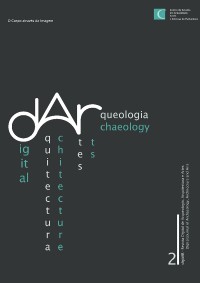Please use this identifier to cite or link to this item:
https://hdl.handle.net/10316.2/39310| DC Field | Value | Language |
|---|---|---|
| dc.contributor.author | Bento, Maria José Travassos | - |
| dc.date.accessioned | 2016-09-01T23:47:58Z | |
| dc.date.accessioned | 2020-09-16T08:29:50Z | - |
| dc.date.available | 2016-09-01T23:47:58Z | |
| dc.date.available | 2020-09-16T08:29:50Z | - |
| dc.date.issued | 2015 | - |
| dc.identifier.issn | 2182-844X (digital) | - |
| dc.identifier.uri | https://hdl.handle.net/10316.2/39310 | - |
| dc.description.abstract | It presents a brief exercise on the extent to which the context itself determines and conducts the observer on his reading of the image of a body. This exercise involves an experience that uses one of the most paradigmatic images of Portugal, the west facade of the Manueline nave of the Convent of Christ, the same one that supports the Chapter window. Arising from a historiographical and visual knowledge of the subject under review, a set of questions is proposed: If we remove the context from all bodies its support which is the result we get? What do you read from each of the bodies, on an individual basis? Does the isolation of the body changes its image and, consequently, the underlying message? I wonder if, when isolated, us is immediate identification of these bodies as belonging to its original context? I wonder if those bodies that were never excluded from its original context, were ever perceived individual in their entirety. And if the exercise consists of inserting, virtually, those same bodies in other different contexts? Does your image or message captured changes? Formalized it, yet, another exercise: How we’ll apprehend any context without the bodies? Will be the hostage of the support elements that constitute it? Leaving these issues, and exemplifying them using image manipulation, a reflection is proposed on the problems in question, with the aim of showing the power of mutation of a body when altered its context. In the extreme, and a route that swells the interrogations, detecting a mined territory analysis of guesswork that may interfere with historical lines assembled and with the intelligibility of objects and cultural and artistic time concerned. | eng |
| dc.description.abstract | Apresenta-se um breve exercício de reflexão sobre até que ponto o contexto, per si, determina e conduz o observador na sua leitura da imagem de um corpo. Este exercício baseia-se uma experiência que utiliza uma das imagens mais paradigmáticas do país, a fachada poente da nave manuelina do Convento de Cristo, a mesma que serve de suporte à emblemática Janela do Capítulo. Decorrente de um conhecimento historiográfico e visual do objecto em análise, elencaram-se um conjunto de questões: Se retirarmos do contexto todos os corpos do seu suporte qual é o resultado que obtemos? Qual a leitura a fazer a cada um dos corpos, de forma individual? Será que o isolamento do corpo altera a sua imagem e, consequentemente, a mensagem que lhe está subjacente? Será que, quando isolados, nos é imediata a identificação desses corpos como pertencentes ao seu contexto original? Será que aqueles corpos que nunca foram excluídos do seu contexto original, foram alguma vez percepcionados na sua totalidade individual? E se o exercício consistir em inserir, virtualmente, esses mesmos corpos noutros contextos distintos? Será que a sua imagem ou a mensagem captada se altera? Formalizou-se, ainda, um outro exercício: Como apreenderemos um qualquer contexto sem os corpos? Será o suporte refém dos elementos que o constituem? Partindo destas questões, e exemplificando-as com recurso à manipulação de imagens, propõe-se uma reflexão sobre as problemáticas em questão, com o objectivo de mostrar o poder de mutação de um corpo quando alterado o seu contexto. No extremo, e num percurso que avoluma as interrogações, detectar-se-á um território de análise minado de conjecturas que podem interferir com linhas historiográficas montadas e com a inteligibilidade dos objectos e do tempo cultural e artístico em causa. | por |
| dc.language.iso | por | - |
| dc.publisher | Centro de Estudos em Arqueologia, Artes e Ciências do Património | - |
| dc.rights | open access | - |
| dc.subject | Body | eng |
| dc.subject | image | eng |
| dc.subject | context | eng |
| dc.subject | Corpo | por |
| dc.subject | imagem | por |
| dc.subject | contexto | por |
| dc.title | Corpos in e ex-situ: problemáticas da contextualização da imagem | por |
| dc.type | article | - |
| uc.publication.collection | digitAR nº 2 | - |
| uc.publication.firstPage | 222 | - |
| uc.publication.issue | 2 | - |
| uc.publication.lastPage | 228 | - |
| uc.publication.location | Coimbra | - |
| uc.publication.journalTitle | digitAR: Revista Digital de Arqueologia, Arquitectura e Artes | - |
| dc.identifier.doi | 10.14195/2182-844X_2_15 | - |
| uc.publication.section | IV - As arquitecturas do corpo | - |
| uc.publication.digCollection | IP | - |
| uc.publication.digCollection | B1 | - |
| uc.publication.orderno | 17 | - |
| uc.publication.area | Artes e Humanidades | - |
| uc.publication.manifest | https://dl.uc.pt/json/iiif/10316.2/39310/216499/manifest?manifest=/json/iiif/10316.2/39310/216499/manifest | - |
| uc.publication.thumbnail | https://dl.uc.pt/retrieve/11260087 | - |
| uc.itemId | 71422 | - |
| uc.thumbnail.uri | https://dl.uc.pt/iiif-imgsrv/11260070/dl!3!12!97!73!129773591642845070365231127488826821752 | - |
| item.fulltext | With Fulltext | - |
| item.grantfulltext | open | - |
| Appears in Collections: | digitAR: Revista Digital de Arqueologia, Arquitectura e Artes | |
Files in This Item:
| File | Description | Size | Format | |
|---|---|---|---|---|
| corpos_in_e_ex-situ_problematicas.pdf | 1.34 MB | Adobe PDF |  |
Items in DSpace are protected by copyright, with all rights reserved, unless otherwise indicated.
